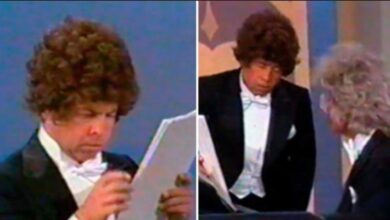Ricky Nelson’s ‘Poor Little Fool’ Makes History as the First Billboard Hot 100 No. 1, Capturing the Spirit of 1958 and an Entire Generation
In the summer of 1958, Ricky Nelson’s “Poor Little Fool” etched its name in history by becoming the very first song to reach number one on the newly launched Billboard Hot 100 chart. Released on July 7 of that year, the track encapsulated the youthful melancholy and emotional complexity of the era, combining a polished vocal delivery with a soft rockabilly edge. More than just a chart-topping single, it signified Nelson’s shift from a television personality to a credible force in popular music.
Nelson’s path to stardom was unlike most of his contemporaries. Born in 1940 to entertainment icons Ozzie and Harriet Nelson, he grew up in the spotlight thanks to the long-running television show The Adventures of Ozzie and Harriet. Though many expected him to follow a purely acting route, his real ambition lay in music. Influenced by pioneers like Carl Perkins and Elvis Presley, Nelson fused traditional rock and roll with a cleaner, pop-friendly style that made him a bridge between rebellious youth and mainstream America.
The story behind “Poor Little Fool” begins with Sharon Sheeley, a teenage songwriter drawing from her own heartbreak. Although she originally intended the song as a slow ballad for a country performer, a backstage meeting with Ricky Nelson changed the trajectory. She convinced him to consider the track, and he saw its potential. Nelson chose to rearrange it with a livelier tempo and a more modern sound, giving the tune a broader appeal for radio and younger audiences.
The recording took place at Master Recorders studio in Hollywood with Nelson’s trusted band, featuring the skilled James Burton on lead guitar. Burton’s smooth, twangy riffs lent the song a sophisticated tone, while the rhythmic bass and drums kept the track grounded in its rockabilly roots. Nelson’s vocal style was subtle yet rich in emotion, striking a balance between heartfelt vulnerability and teen idol charm. The result was a radio-ready hit that resonated with listeners across a wide demographic.
When it hit the airwaves, “Poor Little Fool” caught fire almost instantly. With lyrics that teenagers could relate to and a sound that didn’t alarm conservative parents, the track became a cultural touchpoint. Its rise to number one on the first edition of the Billboard Hot 100 was not only a personal triumph for Nelson but also a landmark moment in music history. It highlighted the changing tastes of a younger generation hungry for its own sound and heroes.
More than a hit, the song signified a shift in American pop culture. Ricky Nelson stood at the crossroads of early rock and mainstream pop, smoothing out the raw edges of the genre while still retaining its emotional urgency. Unlike the untamed performances of Little Richard or Elvis, Nelson brought a gentler, more polished form of rebellion to the forefront—one that parents could tolerate and teenagers could still call their own.
The impact of the song went far beyond that single chart entry. Nelson continued to evolve musically, releasing songs like “Lonesome Town” and “Travelin’ Man,” both of which built on the foundation “Poor Little Fool” had laid. He toured extensively, made numerous television appearances, and became one of the highest-selling artists of the late 1950s. His ability to shift stylistically between rockabilly, pop, and country enabled him to maintain relevance even as musical trends changed rapidly during the following decade.
“Poor Little Fool” didn’t just shape Nelson’s legacy—it also influenced the development of pop-rock songwriting. Its narrative of teenage love and emotional betrayal helped set the tone for countless heartbreak ballads that followed. Artists such as The Everly Brothers and Roy Orbison carried the torch, weaving similar themes into their own work. Nelson had proven that tender stories wrapped in catchy melodies could top charts and define an era.
Many artists have since covered the song, each adding their own interpretation. Country artist Faron Young gave it a more twang-infused rendition, while retro rock bands in later decades revived it as a nod to early rock’s innocence. Yet, no version has captured the same poignancy as Nelson’s original. His calm, measured delivery created a mood that was both sorrowful and sweet, perfectly capturing the song’s emotional core.
At the peak of the song’s success, Nelson was navigating the complexities of fame. As one of the first teen idols, he dealt with intense public scrutiny while striving to be taken seriously as a musician. Despite the challenges, he remained focused on his artistic vision. His dedication to his craft and his willingness to experiment musically helped him maintain a strong presence well into the 1960s and beyond.
Today, “Poor Little Fool” still holds a special place in music history. It is frequently played on classic hits stations and featured in collections that celebrate the early days of rock and roll. As the first number one on the Billboard Hot 100, it serves as a constant reminder of how Ricky Nelson helped shape the sound of a generation and laid the groundwork for future stars.
The song is also a cultural time capsule, capturing the emotional turbulence of teenage life in the 1950s. It spoke to listeners who were beginning to find their voice, using music to navigate their feelings of love, loss, and longing. The simplicity of its message paired with the elegance of its arrangement ensured it would endure long after its chart reign had ended.
“Poor Little Fool” remains more than just a successful single; it is a musical milestone. Ricky Nelson’s interpretation brought a quiet strength and authenticity that helped define the emerging sound of rock and roll. Even as new styles continue to emerge, the song stands as a powerful reminder of the genre’s roots and of an artist who gave it a new, unforgettable voice.





